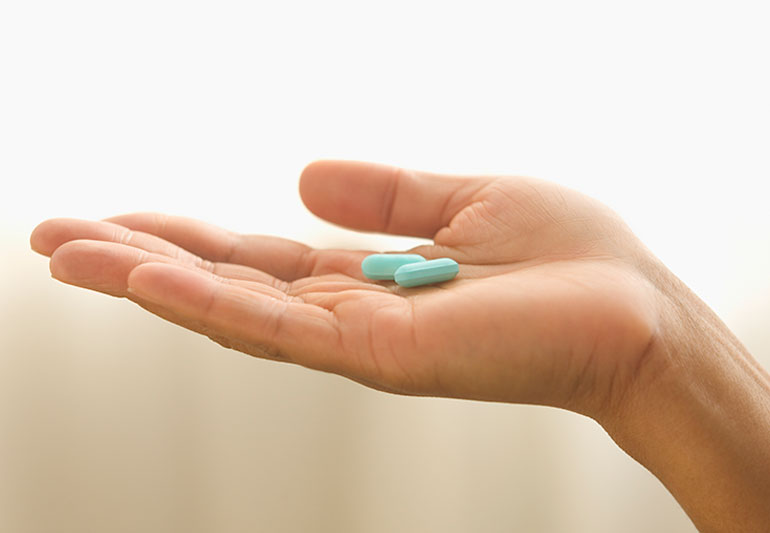

When your doctor asks if you’re allergic to penicillin, do you say yes? Lots of people do.
Penicillin is a commonly-prescribed antibiotic that helps fight off a variety of infections caused by bacteria — from ear aches and sinus infections to pneumonia and meningitis. For a few people, however, it causes an allergic reaction that may include hives, rashes, itchy eyes, fever, shortness of breath, and swollen lips, tongue or face.
About 10% of the population reports a penicillin allergy, but less than 1 in 10 of those people are truly allergic. Moreover, about 80% of those who were once allergic to the drug lose their sensitivity to penicillin after 10 years. So why do so many people think they’re allergic when they’re not? And how can you know for sure?
“Penicillin is the most frequent allergy reported by patients seen at Cleveland Clinic,” says allergy and immunology specialist David Lang, MD. And that is sometimes a problem.
“When a doctor sees you have a label of penicillin allergy, it is often a barrier for getting the most appropriate care in terms of antibiotic selection,” he says.
Reasons you might think you’re allergic (when you’re not)
There are two primary reasons why you may mistakenly think you’re allergic.
1. You had an allergic reaction to something else. You may have noticed a reaction in the past while taking a penicillin-type antibiotic that was not actually caused by the penicillin.
For example, a doctor may give antibiotics for an upper-respiratory infection. Sometimes an infection, particularly in children, also causes a rash, Dr. Lang says. Once you experience symptoms, you get an antibiotic, a rash occurs, and you mistakenly think the penicillin caused the rash.
2. You had other adverse side effects. An adverse reaction to penicillin may lead you to mistakenly believe that you are allergic. For example, penicillin may upset your stomach. While this is a common side effect, it does not mean you’re allergic.
“There are also times when people have coincidental adverse experiences,” says Dr. Lang. For example, you may have a series of headaches or unpleasant symptoms while you are taking the antibiotic, but something else is causing those problems.
Is there a downside to avoiding penicillin?
Yes, says Dr. Lang. You may miss out on the most effective treatment for your condition.
Your doctor must find alternative antibiotics if you have a penicillin allergy. And alternative antibiotics often:
- Are more costly.
- Pose a greater risk for adverse effects.
- Are less effective.
“A penicillin allergy needs to be challenged,” he says. “When we perform a formal allergy evaluation with penicillin skin testing, the results are negative in about every 9 out of 10 patients we evaluate. The negative skin testing implies that penicillin can be taken without an increased risk for allergic reaction compared with the general population.”
How does the testing work?
Skin testing for a penicillin allergy is commonly performed and can be done safely — even in patients who are critically ill or who have had serious reactions to penicillin, Dr. Lang says.
1.Validating the test
To ensure that your skin reacts normally, a nurse will apply both a saline solution and a histamine solution. If your skin reacts to the saline, that means your skin is too sensitive and the test cannot be interpreted.
The histamine solution should cause a red, raised, itchy area, similar to a mosquito bite. If there is no reaction, your skin test may not show an allergy even if you have one, and for this reason the test cannot be interpreted.
If your skin does not react to the saline, but reacts to the histamine, this validates the skin test: Your skin has the capacity to react to a potential allergen.
2. Testing for penicillin allergy
At the same time, a nurse places liquid drops of penicillin on your skin and scratches through the liquid so that it gets underneath the top layer of your skin. A reaction that is similar to a mosquito bite should occur in minutes if you are allergic to penicillin.
If your skin does not react to penicillin, an intradermal test is the next step, which involves a nurse injecting a small amount of penicillin liquids into your skin. After 15 minutes, the skin test is examined for signs of an allergic reaction.
3. Applying a challenge dose
If both the skin-prick and intradermal skin tests are negative, you’ll receive a challenge dose of penicillin or another penicillin-type drug (such as amoxicillin), and then you will be observed for 30 minutes. This challenge dose is important, Dr. Lang says, as it validates the skin testing and demonstrates that you can take penicillin and penicillin-like drugs without an allergic reaction.
more recommended stories
 Circadian Control of Neutrophils in Myocardial Infarction
Circadian Control of Neutrophils in Myocardial InfarctionKey Takeaways for HCPs Neutrophil activity.
 E-Cigarette Use and Heart Attack Risk in Former Smokers
E-Cigarette Use and Heart Attack Risk in Former SmokersKey Takeaways for Clinicians and Nurses.
 Ultramarathon Physiology: What HCPs Should Know?
Ultramarathon Physiology: What HCPs Should Know?Ultramarathon Metabolism: What Happens to the.
 High-Intensity Training and Oxidative Stress Insights
High-Intensity Training and Oxidative Stress InsightsNew Evidence Linking High-Intensity Training and.
 Sterilized Fermented Beverage for Obesity: New Evidence
Sterilized Fermented Beverage for Obesity: New EvidenceEarly Insights Into a Sterilized Fermented.
 Cardiovascular Risk and Sudden Cardiac Death in Diabetes
Cardiovascular Risk and Sudden Cardiac Death in DiabetesRising Sudden Cardiac Death (SCD) Risk.
 Perinatal Mental Health Challenges Highlighted in New Study
Perinatal Mental Health Challenges Highlighted in New StudyMental Health Challenges in New Parents:.
 Walking Speed Before Hip Replacement Predicts Recovery
Walking Speed Before Hip Replacement Predicts RecoveryNew Evidence Points to a Simple,.
 How Soybean Oil Impacts Weight Gain and Metabolism
How Soybean Oil Impacts Weight Gain and MetabolismWhy Soybean Oil May Affect Metabolism.
 New Malaria Prevention Insights From African Biostatistics
New Malaria Prevention Insights From African BiostatisticsHow New Data Is Reframing Malaria.

Leave a Comment